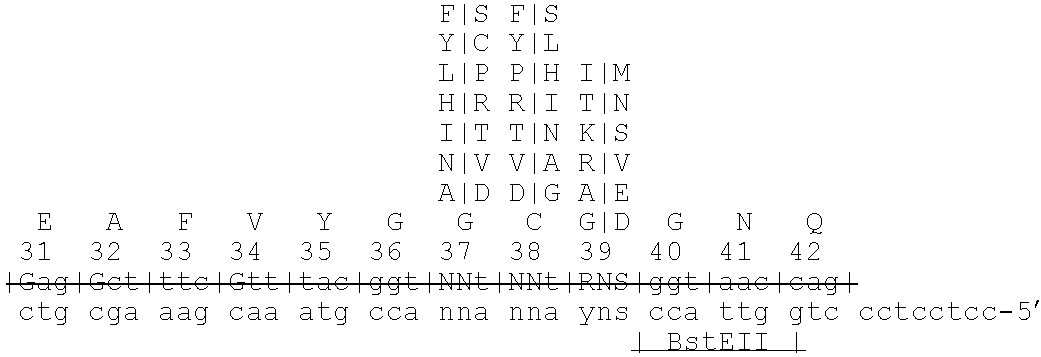Inhibitors of human plasmin derived from the kunitz domains
a technology of human plasmin and inhibitory domain, which is applied in the direction of depsipeptides, peptide/protein ingredients, unknown materials, etc., can solve the problems of high blood loss that cannot be resolved, serious safety issues, and immunological reactions, and achieve the effect of inhibiting human plasmin
- Summary
- Abstract
- Description
- Claims
- Application Information
AI Technical Summary
Benefits of technology
Problems solved by technology
Method used
Image
Examples
example 1
Construction of LACI (K1) Library
[0127]A synthetic oligonucleotide duplex having NsiI- and MluI-compatible ends was cloned into a parental vector (LACI-K1::III) previously cleaved with the above two enzymes. The resultant ligated material was transfected by electroporation into XLIMR (F−) E. coli strain and plated on ampicillin (Ap) plates to obtain phage-generating ApR colonies. The variegation scheme for Phase 1 focuses on the P1 region, and affected residues 13, 16, 17, 18 and 19. It allowed for 6.6×105 different DNA sequences (3.1×105 different protein sequences). The library obtained consisted of 1.4×106 independent cfu's which is approximately a two fold representation of the whole library. The phage stock generated from this plating gave a total titer of 1.4×1013 pfu's in about 3.9 ml, with each independent clone being represented, on average, 1×107 in total and 2.6×106 times per ml of phage stock.
[0128]To allow for variegation of residues 31, 32, 34 and 39 (phase II), synthe...
example 2
Screening of LACI -K1 Library for Binding to Plasmin
[0133]The scheme for selecting LACI-K1 variants that bind plasmin involves incubation of the phage-display library with plasmin-beads (Calbiochem, San Diego, Calif.; catalogue no. 527802) in a buffer (PBS containing 1 mg / ml BSA) before washing away unbound and poorly retained display-phage variants with PBS containing 0.1% Tween 20. The more strongly bound display-phage are eluted with a low pH elution buffer, typically citrate buffer (pH 2.0) containing 1 mg / ml BSA, which is immediately neutralized with Tris buffer to pH 7.5. This process constitutes a single round of selection.
[0134]The neutralized eluted display-phage can be either used:[0135]i) to inoculate an F+ strain of E. coli to generate a new display-phage stock, to be used for subsequent rounds of selection (so-called conventional screening), or[0136]ii) be used directly for another immediate round of selection with the protease beads (so-called quick screening).
Typicall...
PUM
| Property | Measurement | Unit |
|---|---|---|
| molecular weight | aaaaa | aaaaa |
| pH | aaaaa | aaaaa |
| affinity | aaaaa | aaaaa |
Abstract
Description
Claims
Application Information
 Login to View More
Login to View More - R&D
- Intellectual Property
- Life Sciences
- Materials
- Tech Scout
- Unparalleled Data Quality
- Higher Quality Content
- 60% Fewer Hallucinations
Browse by: Latest US Patents, China's latest patents, Technical Efficacy Thesaurus, Application Domain, Technology Topic, Popular Technical Reports.
© 2025 PatSnap. All rights reserved.Legal|Privacy policy|Modern Slavery Act Transparency Statement|Sitemap|About US| Contact US: help@patsnap.com


